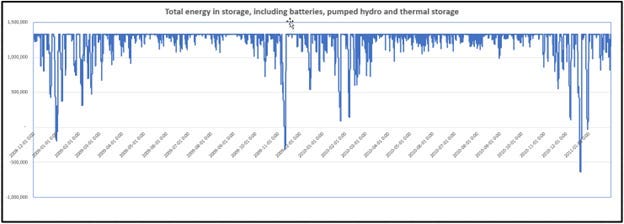A Critique of the Stanford 145 Country Decarbonization Study
In which I point out fundamental errors and misleading cost projections.
This is a critique of a study published by a group led by Mark Z. Jacobson of Stanford University, claiming to show that wind, water and solar power can provide 100% of the future energy needs in 145 countries. I point out several fundamental errors that lead the study to erroneous conclusions and to a gross underestimate of the associated costs.
The referenced study, from Stanford University claims to have modeled the energy use in 145 countries and comes up with a plan for decarbonization of all energy sources in all those countries using only wind, water, and solar, often abbreviated to WWS, although the plan also includes some geothermal energy.
The study of 145 countries is superficial, it presents the results from a computer model that cannot possibly consider all aspects of the task in detail. I would not expect it to be totally accurate, but it contains fundamental errors and misleading statements that render it completely worthless.
I looked only at the proposal for the UK, but the errors I found will apply to all 145 countries and will have the greatest effect on the conclusions for countries where peak energy use is driven by winter heating.
The fundamental error in calculating total energy requirements
The most serious error in the study is in the calculation of total energy needs.
Stanford has proposed Underground Thermal Energy Storage (UTES) as the means of providing building heat. UTES is a system that uses surplus electricity from renewables to heat water which is then stored underground and used for building heat when needed.
Such systems exist at a small scale, but are not common because they are expensive, inefficient and normally need a backup gas boiler or electric heat.
It is important to note that these systems do not employ heat pumps. Their overall thermal efficiency is typically about 50% compared to 400% for a heat pump. This is where the Stanford study makes a major error. It takes the estimated energy required for building heat and instead of multiplying it by 2 to account for the inefficiency of the UTES system, it divides by 4, as if the UTES were a heat pump.
The energy required for building heat is therefore underestimated by a factor 8.
The study also assumes a 9% saving from the elimination of the energy needed to produce and distribute oil and gas. However, the data published by the UK gives end user consumption that already excludes supply and distribution losses. In fact, Stanford’s estimate must be increased to allow for electricity distribution losses.
These two errors together result in Stanford’s underestimating the total energy requirements by a factor of 2.
Electricity storage
In the Stanford study, energy generation is provided mostly by wind, solar, and some tidal and wave power as per the table below:
There is a combined 156.5 GW of wind power and 346.5 GW of solar power plus 14.4 GW of new wave and tidal power. Hydroelectric power already exists, and the UK has very little potential to increase hydroelectric power.
Below is a list of the proposed storage facilities:
There is a total of 8.6 TWh of storage that can be used to generate electricity. However, 7.27 TWh of that is restricted in that it can only generate 1.9 GW of power, the limit of existing hydroelectric generators. The proposed batteries have more than enough input and output capacity, but only two hours of storage at full capacity (100 GW of 10-hour battery would be a better choice).
Basically, the study is proposing a massive overbuild of renewables, especially wind and solar. The total installed nominal generating capacity is 520 GW to service an average load of 48.03 GW (of which 7.73 GW can be adjusted by demand response). During periods when the wind is blowing and the sun is shining, the oversupply goes to heating water and storing it underground for use as building heat, and anything left over is used to make hydrogen for industry.
The major storage component is heat in the form of hot water stored underground which cannot be used to generate electricity.
Stanford used a climate prediction model to simulate the wind and solar generation for 2050, and their conclusions were checked against a typical year of weather data. I think a better approach would be to use historical data, I have chosen the period between December 2008 and February 2011, because that was a period when winds were light, and temperatures were below average. (These systems must be designed for worst-case conditions, using averages will not give you a reliable, robust system). Inputting the proposed WWS generators into a simulation, using Stanford’s estimates of demand, I found that there are four periods when the storage runs out, and there is not enough generating capacity to meet demand:
The chart above shows the amount of energy in storage at any time, excluding the hydro reservoirs (assuming a starting point of full storage). In my analysis I used the hydro storage whenever the batteries and other storage fell below the maximum. Most of the time, the storage is full, and the batteries are fully charged and on standby for periods when the renewables fail to deliver. Those periods of inadequate power occur in winter when solar energy is at its weakest, and during a period of low wind. The batteries drain very quickly and there is not enough reliable power to meet demand. That happened four times during the two-year period analyzed.
Demand response does not help very much, the problem cannot be solved by a temporary dip in demand during peak hours. The problem is a severe shortage of flexible generating capacity. What the system needs is a baseload of reliable power generators that can produce power when there is no wind or solar.
The chart illustrates the stupidity of using batteries as storage for a grid that relies on wind power. The very expensive batteries must sit fully charged for long periods, waiting for a wind drought, they only discharge fully one or two times a year and rarely use more than a fraction of their capacity.
It also illustrates the stupidity of aiming for zero emissions with a wind and solar-dominated grid. A backup power supply using diesel generators could eliminate the need for most of those massive batteries and still achieve emission reductions well above ninety percent.
Minor changes in assumptions and the fact that I used a worst-case year for wind loads probably explain the difference between my analysis and Stanford’s with respect to electrical storage needs, but what is being proposed is a long way from being a reliable grid.
Thermal energy storage
Let’s move on to look at the proposed system of domestic hot water and building heat, the underground thermal storage system or UTES
Stanford’s parameters for the UTES system are:
Maximum input 49.46 GW (49 GW from oversupply of wind and solar)
Maximum output 32.66 GW
Storage 11.76 TWh
A number of studies have attempted to predict peak UK domestic gas demand, including this paper by S.D.Watson at Loughborough University. He comes up with a figure of 170 GW including heating and domestic hot water. The 170 GW is gas consumption, which translates to 136 GW of heat required to cover peak demand at 80% boiler efficiency. It is the lowest estimate among several studies that I read, and it includes only domestic consumption; heating for commercial buildings is not included. It is more likely that I have underestimated rather than overestimated demand.
However, at 32.66 GW, Stanford’s estimate of the maximum required UTES heat output is off by a factor of more than 4.
But the shortfall in peak output is not the biggest discrepancy, that honor belongs to the lack of adequate storage. The chart below (taken from the S.D.Watson paper) shows the domestic heat load over the course of the year. As expected, the bulk of the heat load is in the colder months from November to May
Here’s a chart showing the surplus electricity that would be available from the proposed WWS generators:
As you can see, the supply is totally out of sync with the demand. Massive storage is needed to capture the surplus energy from the summer months to provide heat for the winter. An analysis of wind and solar capacity factors for the 2009/2010 period shows a requirement to store about 250 TWh of input energy, enough for 140 TWh of output heat.
Stanford’s estimate for heat storage (11.74 GWh) is off by a factor of more than 12.
Misleading statements about costs
The Stanford study tells us that the plan will have an upfront cost of $880 billion, I quote from their report:
“Has an upfront cost of $880 billion (for WWS electricity, heat, H2 generation; electricity, heat, cold, H2 storage; short- and long-distance transmission; distribution)”
Let’s take a closer look at that cost estimate (using Stanford’s unit costs for the generating facilities).
Although the study claims to have included storage, hydrogen, transmission, and distribution, the figure for generation alone exceeds the claimed $880 billion. (I omitted the existing hydro facilities from the costs, but I included all existing wind and solar since all will reach their end of life by 2050).
To that figure, we need to add the cost of 970 GWh of batteries, which I estimate to be $300 billion for a total of $1.218 trillion.
However, as I pointed out earlier, that only provides about half of the required energy, we need to double everything to get the real costs. So, now we are at $2.4 trillion plus transmission and distribution costs which will likely add another $100 billion or more.
Finally, we need to add the UTES system, which the Stanford team seems to have omitted from their cost estimates.
The cost is difficult to estimate. A report from the International Renewable Energy Agency (IRENA) gives a range of 0.1 to 35 $/kWh. The fact that the upper end of the range is 350 times the lower end indicates the level of uncertainty and lack of real background data on such systems.
If we take the middle of that range ($17.50/kWh) and 140 TWh per year of output heat, we arrive at a figure of $2.45 trillion. That seems like a high number but considering that it involves drilling thousands of deep boreholes, and building a pumping and distribution system to route hot water to every building in the country, I question whether it is even practical at any cost.
So, the real cost of the complete energy transition using Stanford’s proposed methods will be around $5 trillion. That’s for an energy supply that might fail during a wind drought and leave the country without power, or without any means of heating during an exceptionally cold winter.
I think I’d rather take my chances with heat pumps and nuclear power, thankyou.
Note: Some of this may seem familiar to some readers. It is rewrite of an earlier article which I published before I discovered the root cause of Stanford’s underestimation of energy requirements.










Personally I'd give the heat pump a miss. Nobody, except those selling them, seem to have a high opinion of them.
This whole thing suggested by Stanford is an exercise in stupidity of monstrous proportions. It wasn't published on April 1st was it?
Hi, jaberwock. I posted a thread about this at blue sky. I would appreciate you taking a look at it and responding to any of the criticisms. Thanks.